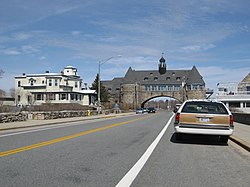2020 census
The 2020 United States census counted 14,532 people and 6,097 households in Narragansett. The population density was 1,048.1 inhabitants per square mile (404.7/km2). There were 9,857 housing units in the town. The racial makeup was 93.28% white or European American, 0.56% black or African-American, 0.50% Native American or Alaska Native, 1.31% Asian, 0.05% Pacific Islander or Native Hawaiian, 0.81% from other races, and 3.48% from two or more races. Hispanic or Latino of any race was 2.05% of the population.
Of the 6,097 households, 15.3% had children under the age of 18; 40.3% were married couples living together; 36.1% had a female householder with no spouse present. 11.4% of households consisted of individuals and 3.9% had someone living alone who was 65 years of age or older. The percent of those with a bachelor’s degree or higher was estimated to be 42.3% of the population. [7]
11.4% of the population was under the age of 18, 22.3% from 18 to 24, 15.4% from 25 to 44, 27.1% from 45 to 64, and 23.7% who were 65 years of age or older. The median age was 46.2 years.
The 2016-2020 5-year American Community Survey estimates show that the median household income was $79,056 (with a margin of error of +/- $16,106) and the median family income was $125,357 (+/- $25,707). Males had a median income of $52,738 (+/- $15,287) versus $20,882 (+/- $20,090) for females. [8] The median income for those above 16 years old was $31,056 (+/- $18,353). [9] Approximately 8.2% of families and 17.9% of the population were below the poverty line, including 0.0% of those under the age of 18 and 8.0% of those ages 65 or over. [10] [11]
2000 census
As of the census [1] of 2000, there were 16,361 people, 6,846 households, and 3,847 families residing in the town. The population density was 1,156.5 inhabitants per square mile (446.5/km2). There were 9,159 housing units at an average density of 647.4 per square mile (250.0/km2). The racial makeup of the town was 95.84% White, 0.75% African American, 0.90% Native American, 0.76% Asian, 0.02% Pacific Islander, 0.34% from other races, and 1.40% from two or more races. Hispanic or Latino of any race were 1.25% of the population.
There were 6,846 households, out of which 22.0% had children under the age of 18 living with them, 44.6% were married couples living together, 8.7% had a female householder with no husband present, and 43.8% were non-families. Of all households 27.2% were made up of individuals, and 9.0% had someone living alone who was 65 years of age or older. The average household size was 2.38 and the average family size was 2.86.
In the town, the population was spread out, with 17.3% under the age of 18, 19.6% from 18 to 24, 25.0% from 25 to 44, 24.6% from 45 to 64, and 13.5% who were 65 years of age or older. The median age was 36 years. For every 100 females, there were 94.5 males. For every 100 females age 18 and over, there were 92.4 males.
The median income for a household in the town was $50,363, and the median income for a family was $67,571. Males had a median income of $45,436 versus $31,759 for females. The per capita income for the town was $28,194. About 4.9% of families and 16.0% of the population were below the poverty line, including 8.4% of those under age 18 and 5.0% of those age 65 or over. In 2010, Narragansett was estimated to have 2,743 people in poverty; college students represented 71% of that group, and in comparison, statewide college students make up only 13.7 percent of the total population in poverty. This large college factor, in a relatively small community, has a profound impact on the overall poverty rate. [3]
From September through May the town is home to many students from the University of Rhode Island located in nearby Kingston.







